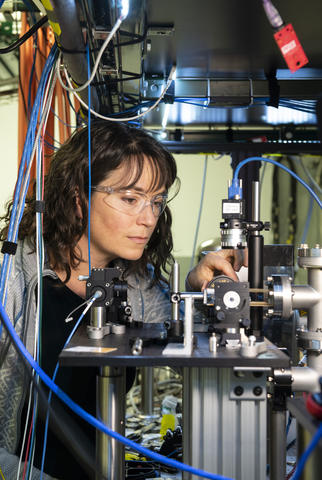
For NIST physicist Julia Scherschligt, the most exciting thing about quantum is seeing the real-world applications of this science. Julia leads a group that is using ultracold atoms, which follow the rules of quantum physics — the study of energy and matter at the smallest level — in ways that are useful in fields that require gravitational wave detectors and particle accelerators.
Scientists in these areas use vacuum chambers, which are almost completely devoid of atoms or other potential contaminants. No vacuum chamber is ever entirely free of such particles, but scientists can determine how many are present by measuring the tiny pressures they exert on the chamber.
To create more pristine vacuum environments, researchers must keep the chambers largely free of contaminants by continuously monitoring the vacuum pressure as it gets even lower. But how can scientists measure these ultralow pressures?
The solution: Julia and her group have created a method known as the cold-atom vacuum standard (CAVS). CAVS injects a cloud of ultracold lithium atoms into the vacuum chamber. The cloud of atoms, held in place by magnetic fields, glows when a laser shines on it. The exact intensity of the glow depends precisely on well-known principles of quantum physics.
Meanwhile, particles in the vacuum chamber occasionally collide with the atoms, knocking them out of the cloud and reducing the intensity of the glow. This reduction in intensity allows the researchers to determine the rate of atoms leaving the trap (and therefore the number of particles in the chamber), giving an accurate measurement of vacuum pressure.
The CAVS technique is a primary standard, meaning it measures pressure by depending on the principles of quantum mechanics and without requiring external calibrations or proprietary methods. CAVS pressure measurements are reliable and consistent because they can be linked back to the basic units of pressure in the SI, or metric system.
CAVS also might be useful for maintaining the controlled vacuum environments required for many forms of quantum computing and making advanced computer chips.
“What’s really valuable with this new way of approaching problems with quantum is the idea that it democratizes these technologies. For example, if I do an experiment to measure current by counting the number of electrons in a wire, that’s a quantum problem. Everyone has access to the exact same tools, and it levels the playing field. It’s an extraordinary outcome of quantum,” says Julia.
Follow us on social media for more like this from all across NIST!

